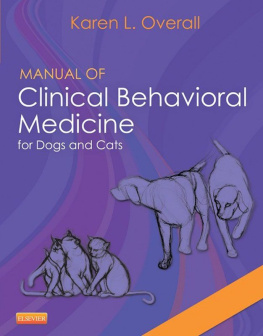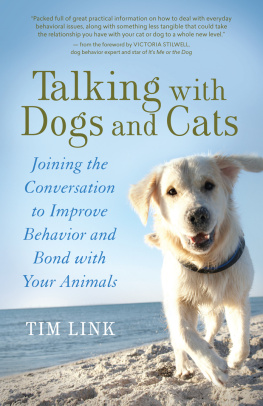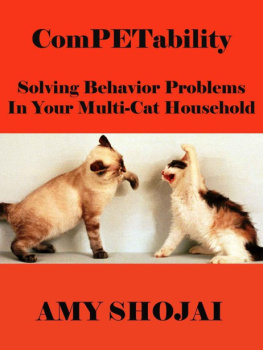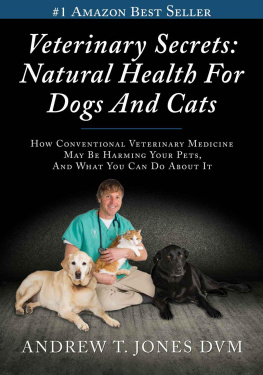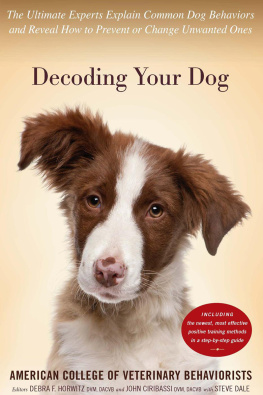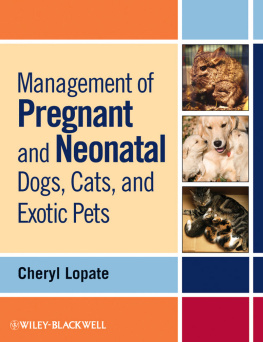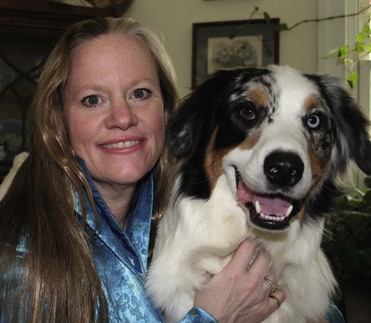Dr. Karen L. Overall holds BA, MA, and VMD degrees from the University of Pennsylvania and a PhD degree from the University of Wisconsin-Madison. She did her residency training in veterinary behavioral medicine at the University of Pennsylvania, and is a Diplomate of the American College of Veterinary Behaviorists (DACVB). Dr. Overall is also certified by the Animal Behavior Society as an Applied Animal Behaviorist (CAAB). She has served for more than 20 years on the faculties of both the veterinary and medical schools at the University of Pennsylvania where she has taught undergraduates, graduate students, and professional students with great joy and to rave reviews, and she ran the Behavior Clinic at Penn Vet for more than a dozen years.
Dr. Overall has given hundreds of national and international presentations and short courses and is the author of over 100 scholarly publications, dozens of textbook chapters, and the text Clinical Behavioral Medicine for Small Animals (1997). She is the editor-in-chief for Journal of Veterinary Behavior: Clinical Applications and Research (Elsevier). Dr. Overall has been named the North American Veterinary Conference (NAVC) Small Animal Speaker of the Year, has been awarded the Cat Writers Association Certificate of Excellence for The Social Cat column in Cat Fancy magazine, and in 2010 was named one of the Barks 100 Best and BrightestBark magazines list of the 100 most influential people in the dog world over the past 25 years.
Dr. Overall serves and has served on numerous governmental committees focused on canine health and behavior, including the Commonwealth of Pennsylvanias Canine Health Board, to which she was appointed by former PA Governor Rendell, and the U.S. Department of Defenses Blue Ribbon panel on caninepost-traumatic stress disorder (C-PTSD). She frequently consults with governments locally, nationally, and internationally about scientific, legal and welfare issues of pet dogs and behavioral assessment, welfare, and performance issues pertaining to working dogs, in which capacity she co-chaired the U.S. governments FBI Scientific Working Group on Dogs and Orthogonal Detection Methods (SWGDOG) for 7 years.
Dr. Overalls research focuses on neurobehavioral genetics of dogs, the development of normal and abnormal behaviors and how we assess behavior, especially as concerns working dogs. Her favorite collaborator is still her husband, Dr. Art Dunham, who understands how important it is to her to have a life of the mind and who shares her interests in political activism, art, classical music, and the value of travel for learning about languages, cultures, food, wine, and friendship. Having decided that the carrying capacity of their canine household was four dogs, they continue to live with four much loved, rescue Australian shepherds in a shifting array necessitated by the unfortunate disparities between human and canine demographics.
Copyright

Elsevier
3251 Riverport Lane
St. Louis, MO 63043
MANUAL OF CLINICAL BEHAVIORAL MEDICINE FOR DOGS AND CATS ISBN: 978-0-323-00890-7
Copyright 2013 by Mosby, an imprint of Elsevier Inc.
No part of this publication may be reproduced or transmitted in any form or by any means, electronic or mechanical, including photocopying, recording, or any information storage and retrieval system, without permission in writing from the publisher. Details on how to seek permission, further information about the Publishers permissions policies, and our arrangements with organizations such as the Copyright Clearance Center and the Copyright Licensing Agency can be found at our website: www.elsevier.com/permissions.
This book and the individual contributions contained in it are protected under copyright by the Publisher (other than as may be noted herein).
Notices
Knowledge and best practice in this field are constantly changing. As new research and experience broaden our understanding, changes in research methods, professional practices, or medical treatment may become necessary.
Practitioners and researchers must always rely on their own experience and knowledge in evaluating and using any information, methods, compounds, or experiments described herein. In using such information or methods they should be mindful of their own safety and the safety of others, including parties for whom they have a professional responsibility.
With respect to any drug or pharmaceutical products identified, readers are advised to check the most current information provided (i) on procedures featured or (ii) by the manufacturer of each product to be administered, to verify the recommended dose or formula, the method and duration of administration, and contraindications. It is the responsibility of practitioners, relying on their own experience and knowledge of their patients, to make diagnoses, to determine dosages and the best treatment for each individual patient, and to take all appropriate safety precautions.
To the fullest extent of the law, neither the Publisher nor the authors, contributors, or editors, assume any liability for any injury and/or damage to persons or property as a matter of products liability, negligence or otherwise, or from any use or operation of any methods, products, instructions, or ideas contained in the material herein.
ISBN: 978-0-323-00890-7
Vice President and Publisher: Linda Duncan
Content Strategy Director: Penny Rudolph
Content Development Specialist: Brandi Graham
Publishing Services Manager: Catherine Jackson
Senior Project Manager: Carol OConnell
Designer: Margaret Reid
Cover Photo: A.E. Dunham
Printed in Canada
Last digit is the print number:987654321 
Dedication
This text is dedicated to my dogsall Australian shepherds, save one, who are always constrained by their circumstances to be both teacher and studentand to my husband. I love them all so much.
For Maggie, smart, astute, and generous. Maggie possessed selfless courage. Everyone who met Maggie loved her, and she never met a human or another animal with whom she would not share. She was Tesss eyes and my constant companion. Maggie taught me to love unconditionally.
For troubled Tess, blind by 5 weeks and taken home at 8.5 weeks, who taught me about struggle, recovery, and forgiveness. Tessie had toughness but infinite sweetness, too, and far from being a throw-away at 5 weeks, she died in her sleep 1 month short of 15 years.
For feisty Little Bit, the only non-Aussie in the group, who showed me that sometimes pure orneriness has a place and that perseverance can make all the difference. Adopted at 13 years into a home of Aussies, she held her own among the big dogs, often barking back-up for them. She was cared for in her final illness at 22 years by the new dog, Flash. She captured all of our hearts.

